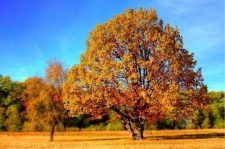Description: Budworms can be brown, purple, red or green depending on the host plant it’s consuming. It has white stripes on the abdomen that run the length of the 1 ¾-inch body. There are hairs on the body as well. Adult moths are greenish-brown with a wingspan of about 1 ¼-inches.
Life Cycle: There are two generations of budworms each year with the second generation typically being the more destructive. They can overwinter as pupae several inches beneath the soil surface during mild winters outdoors or in container plants that are brought indoors as well as in the soil of protected patios.
Damage: Budworms are common on petunias, geraniums, nicotiana, roses and other ornamentals. The larvae bore a hole through the flower buds and feed on the petals. Buds may drop prematurely or, if not, the resulting bloom will show damage from the feeding. Larvae also drop black feces on the buds.
Control: Manual removal can be effective if plants are monitored regularly. Winters with temperatures that drop below 20 degrees F can kill overwintering pupae if they are not in protected environments.
Chemical controls such as permethrin (Bonide Eight and Hi-Yield Lawn, Garden and Farm Insect Control), esfenvalerate (Asana, Bug Buster II), bifenthrin (Hi-Yield Bug Blaster Bifenthrin) or gamma-cyhalothrin (Spectracide Triazicide). Products with the organic active ingredient Spinosad (Natural Guard Spinosad, Captain Jack’s Dead Bug Brew, Monterey Garden Insect Spray) may also be effective.
Cynthia Domenghini, Extension Agent




